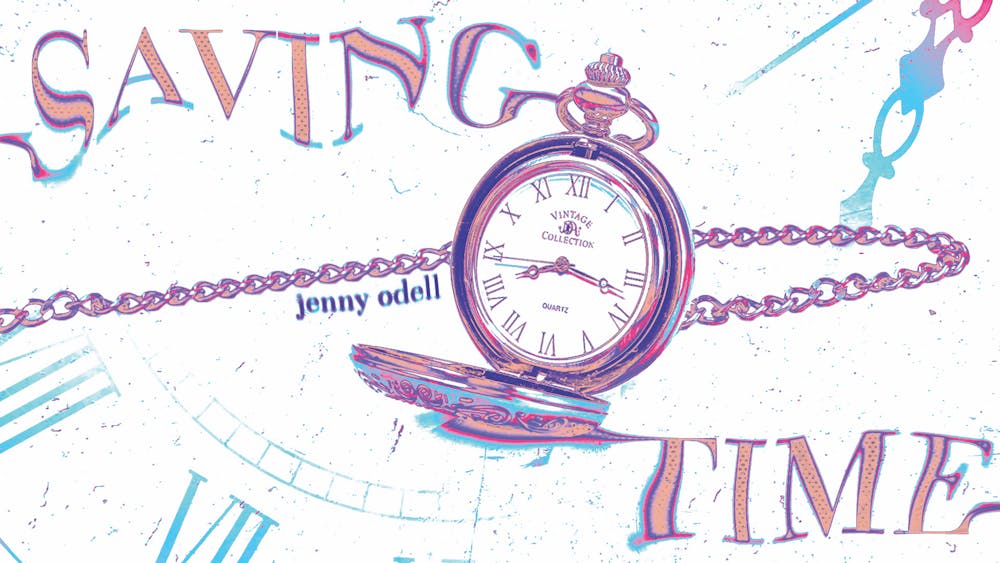My life lives on Google Calendar. Each hour of my life is carefully measured and categorized in beautiful color–coded blocks that account for everything from my class schedule to lunches with friends to “Rotting in Van Pelt.” During the school year, I would play a solo game of Jenga on Sunday night, attempting to figure out how to fit everything on my to–do list into the 168 hours I had in a week. In some ways, my Google Calendar is a diary of my existence, a catalogue of how I spend my waking days—or at least intend to, considering the plethora of 6 a.m. runs scattered throughout my calendar that I've definitely slept through.
In elementary school, my friend Victoria and I would spend all of recess in a never–ending search for “time–stopping crystals,” never quite successful in our almighty attempts to bend the space–time continuum. When I found out I couldn’t stop time, I instead learned to budget the time that I had the way you would balance finances, making sure nothing went to waste. Each hour was an investment in myself or in my future—that time yet to come. Time was precious.
But there was a time before I was obsessed with time, before I even knew what an hour was. When the passing of time was marked not by the ticking of a clock or the numbers on a calendar, but instead by something more tangible—my mom coming home from work, my height on the wall, the setting sun.
This is the world that Jenny Odell seeks to reclaim in Saving Time: Discovering a Life Beyond the Clock. Published at the start of this summer, Saving Time is an academic exploration and artistic inquiry into our perception of time. Following Odell’s critically acclaimed book, How to Do Nothing, the California–based multidisciplinarian continues to evade the labels of genre in her second novel. She fluidly travels from personal memoir to scientific ecology, only to jump to academic history and then swim back to philosophy. But then again, Odell has never been a fan of convention, seeking to deconstruct our very definition of time.
It’s difficult to decenter ourselves from our rigid, mathematical conception of time constructed of hours and minutes. Growing up, my mom made up a bedtime story about a day when all clocks disappeared. According to her, such a day would be analogous to the punctuality purge, with everyone late and in utter disarray. Nothing could get done. But, as Odell points out, in the grand scheme of human history, clocks are a relatively recent invention, gaining their status as a fixture of modern life during the Industrial Revolution, as the standardization of time was deemed critical for businesses and labor to coordinate and run more efficiently. Many of our contemporary ideas of time have their roots in the emergence of capitalism of that era, from the economic relationship with time built out of wage labor to the very fact we view time as a commodity spent and wasted.
As Saving Time traces the emergence of our modern obsession with time from economics to ecology, it offers insight into our relationship with the world around us. Take the seasons, for example. Odell posits that the modern concept of the contemporary seasons is simply a colonial construction, taken from the weather patterns of Western Europe. For the rest of the world, however, the year can hardly be divided into the four seasons that we’ve learned since elementary school. For some regions, rain marks the changing of seasons with wet and dry categorized as delineators; for others, certain foliage is associated with the passing of time. Here in Houston, you have mosquitos. This concept of time connects us to the physical world around us, rather than an abstract concept imposed from above (or by a groundhog, depending on who you ask). After all, throughout most of human history, time was measured by a change in nature—whether it was shadows cast by the sun or the phases of the moon. Compared to our traditional concepts of time, it's easy to see how disconnected modern time is from the physical world we inhabit. Anyone suffering from that notorious Philly winter gloom can attest to that disembodied feeling of the sun setting while still in class.
In an era of major physical change to our natural environment, Saving Time is also a call to action against climate change. After all, what does it mean for our carefully constructed seasons when the fauna that once signaled the changing seasons disappears? In our disembodied idea of time, climate change is merely a sign of rising temperatures, but when we reconnect time to our physical environment, these changes are much deeper. It is a deconstruction of our entire ecological clock—as if months from our calendar just disappear. In many ways, our divorced idea of time grants us a certain privilege to ignore the climate crisis—but Odell is bringing us back to Earth.
We often lament that there are simply not enough hours in the day, but this obsession often prevents us from enjoying our time as it is. Rather than living in the moment, we try to squeeze each one as small as possible so we can get to the next thing as quick as possible. It’s easy to feel that pressure to fill each hour of your day with some arbitrary “productive” activity, computing time calculus to get the most out of your day and then feeling guilty when the sun goes down that you weren't efficient enough. Saving Time by Jenny Odell offers a refreshingly new perspective that forces us to reset our internal clock and ask who even built that clock in the first place.
As of now, Odell’s book isn’t catalyzing any Google Calendar revolution. After all, modern times require modern time. But, it will undoubtedly force you to slow down and examine life from beyond those color–coded blocks on your screen.







